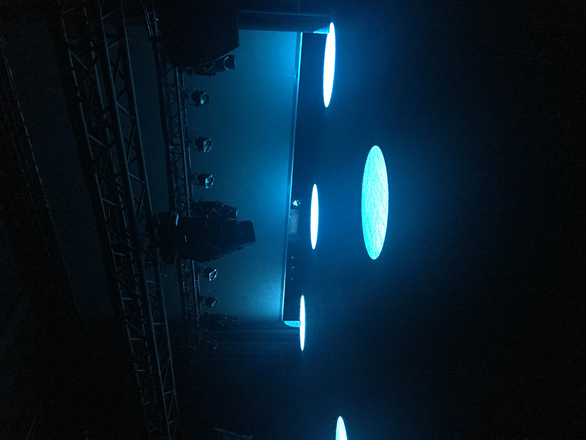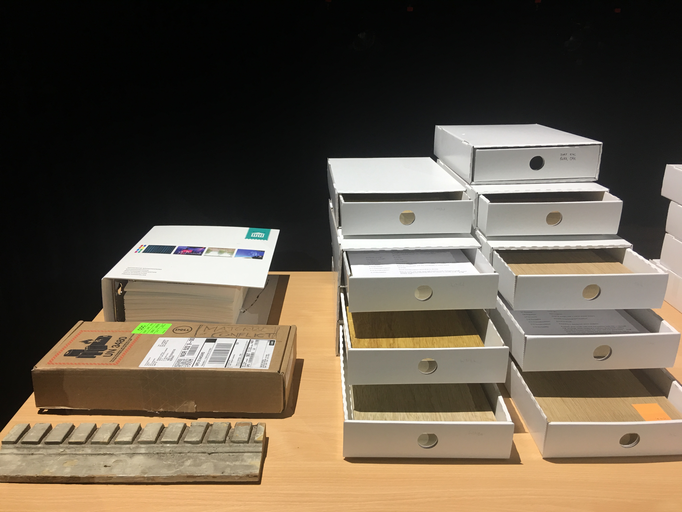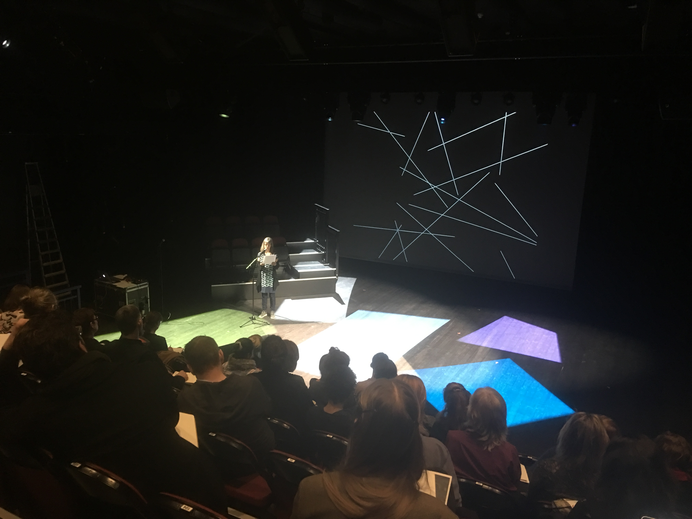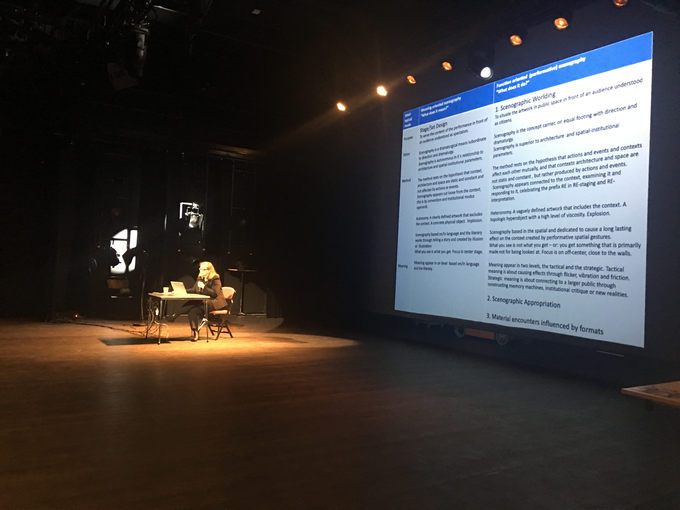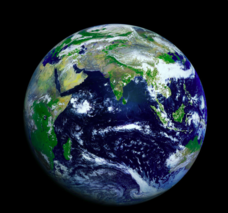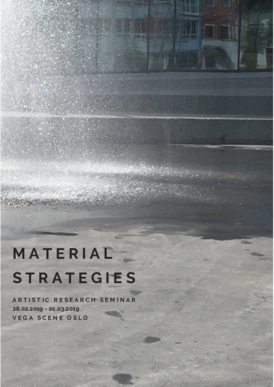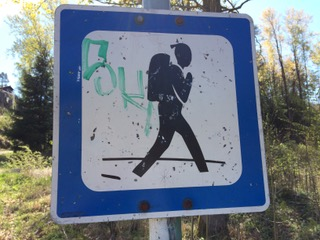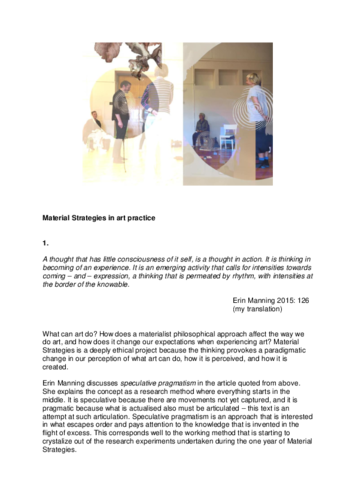Dramaturgy, Society and the Body, the potentials of Physical Action
IPPT – International Platform for Performance Training
Gothenburg 18-19. January 2019
References:
Benso, S. (2000) The Face of Things, A Different Side of Ethics, Albany: State University of New York Press
Braidotti, R. (2011) Nomadic Theory, Columbia University Press, New York
SETTING THE FRAME
by Camilla Eeg-Tverbakk
Welcome to this two days seminar connected to the artistic research project MATERIAL STRATEGIES, generously funded by NARP (Norwegian Artistic Research Program). Instead of setting the frame, I should have called my introduction here today setting a frame, since we are focussing on things in transformation and not trying to fixate or capture things. I hope we can use this time together to explore aspects of materialist thinking and object oriented philosophy, and how it opens new perspectives and questions ways in which we practice art making. We are not necessarily looking for results, but to inspire each other through sharing ideas and approaches to how we understand the materials we work with and how they affect us and co-create with us. These matters are about the relationships we live with other humans and things around us. Essentially this is about the ethics we practice in work and life. How does our relation to things affect us?
For instance, can you take out your cell phones and make a ‘selfie’ with your neighbour? Then ask if he or she wants you to keep it or delete it.
Would you be willing to separate with your phone for a moment? If so, you can put it here on the floor, with a name tag – I put my phone down.
Archeologist Ian Hodder writes about the ways in which we are entangled with things. How we are living our lives in a web of entanglements with things. Just look around this room, we are dependent on many things. Hodder is interested in the reciprocal relationships where humans form things and things form humans through the notion of co-dependence. Human and non-human entities live and function in interdependency through a web of entanglement, which constantly evolves and grows. Material things, thoughts, games, institutions and knowledge are all things that need to be attached to other things and entities in order to have a function for humans. Thus humans are also part of this web, or dance, of connections between things on equal terms as all other material.
Science has shown that every thing, including human bodies, are made of particles. Each particle consists of even smaller particles and so on, and finally there is nothing thus ‘nothing really exists’ or as Hodder comments ‘[A]t the atomic and sub-atomic level we see that matter ‘becomes’ rather than ‘is’’ (2012: 209). If this is the case, we can speak of the ways in which matter flows from one form to the other, and into and with each other. Almost like a dance or choreographic movement of energies. When speaking of ethics, Hodder is concerned with how difficult it is to stop our dance with things, constantly creating new and broader networks of entanglements. We know for example how getting one thing, often brings on lots of other things like chargers, new batteries, adaptors etc. in order to keep the first thing functioning.
Object Oriented Ontology (OOO) speaks about how all things, including our bodies, dreams, memories, texts etc., are in constant processes of transformation. Whatever a thing stands in relation to in a specific moment reveals different sides of the thing. Things reveals and withdraws through constant movement and processes of transformation, which means we can never grasp the real-real, or entire reality of any thing. It is in a constant process of becoming. How is our art practices affected if we challenge the anthropocentric position and see our selves, my body, mind, thoughts, visions, as things more equal to other things? How can we as artists to a greater extent listen to the agency of the material and explore how it shapes us and our artistic work? How does things and material shape itself without our interference?
New Materialism is focusing more on process and the relations between humans and things, and on many points they oppose OOO. However this is not a seminar debating philosophical strands, but an artistic research forum that allows us to freely dialogue with various concepts and ideas to see what can push our understanding of artistic practice into new territories. How does a materialist approach affect our perception of the world?
I love this image. Although I have never been in outer space looking back on the planet-thing, I am still struck by what is called ‘the overview effect’. This thing, which we have named earth or Tellus, when seen from this perspective – is a perfect example of the fact that we can never grasp reality. We will always only see a thing from one specific angle, and then we can argue which angle is the right one – but through this perhaps miss the point and many opportunities of sensing the real. When seeing the thing we exist on and depend on for our survival, from this perspective, the interplays, the co-dependencies and the entanglements seem obvious. Can we consider a picture like this ‘data’? Is this image what we call ‘fact’, and is data and facts telling us ‘the truth’? Any data involves an interpretation, so this image, which is a thing, is something we interpret – think with, dream with and envision in different ways. The image exists when it is seen and entangled with a viewer. For sure, this is not the planet earth, because we can never experience the real planet earth. Each of us can only interpret the data each of us have experienced in our relation with this planet. Perhaps this is also our problem since we think we know it, or at least we want to think we know it and thus can control it. Planet Earth is what Timothy Morton calls a Hyperobject. It is impossible to capture the planet in a photo, since the planet does not really exist. What exists is an assemblage of moving parts in constant transformation: stones, water, sand, winds, animals, people, seeds growing into plants and trees, things being built and breaking down. Morton says in his new book Being Ecological: ‘Data is shifty, data isn’t things, and data is all you’ve got’ and continues ‘maybe ecological facts require that we don’t immediately ‘know’ exactly what to do.’ So, when exploring processes of art making from a materialist point of view, means to not have the overview, to accept there are known and unknown aspects of the work, which challenges notions of authorship, quality and professionalism.
Environmental questions become acute when looking at this image. Our world-view connects to our ethics, our beliefs that is the ground from which we act and relate to and with other things. What happens to perceptions of subjectivity, human imagination and memories from a materialist point of view?
Is this body ‘mine’? We know that our bodies are assemblies of different bio cultures, and that our digestive system probably controls our thinking more than vice versa. Theories of embodiment have made an important step towards the present renewed interest in materiality. The materialism of the body, within this context, is to see the body as an assemblage of various forms of materiality connected and relating to all other things also made from the same, or similar, forms of matter. This is not a holistic position, but a relational one. ‘In a world of vibrant matter, it is not enough to say that we are “embodied”. We are, rather, an array of bodies, many different kinds of them in a nested set of microbiomes’ (Bennett, 2010: 112).
If we let go of the anthropocentric perspective, how then do human ideas, emotions, visions and memories come into play when the artistic strategy calls for less power and control over the material? How does the environment we live in and with affect our thinking, our dreaming and our movements? What happens to our Western notions of quality, tonality and perspective when we accept giving away control, listen more and occupy less space in our creative processes? Who owns a material, a song tradition or method? What happens to questions of appropriation and decolonization? Who’s stories do we tell, and who are we telling them?
How are performative and material practices articulating the embodied nature of memory?
Michael Taussig writes about the drawings he makes in his anthropological field diaries in the book I Swear I Saw This (2011). He introduces doubt as a quality, which is always part of a representation of something that happened in the past. How can we be sure we are transmitting any kind of ‘truth’ of what happened, and how can we be certain about anything in a world of floating things in transformation? Taussig argues for his drawings as a way of remembering and documenting - suggesting ‘a world beyond, a world that does not have to be explicitly recorded and is in fact all the more “complete” because it cannot be completed. In pointing away from the real, they capture something invisible’ (Taussig, 2011: 13) or unknown we could add. Creating images of what has been seen belongs to the world of play.
Giorgio Agamben (1999) has written about testimony, witnessing, and the archive, especially in relation to the holocaust, and argues that the ‘true’ witness is the one who did not survive. We make fiction intelligible as a way to understand what cannot be understood. When the stories from the concentration camps started leaking out to the public, they were too horrible to believe even with photographic documentation of the atrocities. Agamben writes that his book is an attempt to listen to the absence, that which cannot be told because the survivors, the witnesses are bearing witness to something that is impossible to bear witness to, something unbelievable thus impossible to see (13).
Memories, like everything else, are things entangled and connected to other things being formed by them, and forming them reciprocally. What we as humans are able to imagine creates our physical world—it is from these mental visions we create reality. Memory is a creative act, a performance, writes Liedeke Plate and Anneke Smelik (2013: 2). Memory only exists in the present when it is performed. Memory is work and a practice; thus, memory has agency. Memory is ‘intimately connected with making, with narrating, telling and writing — in short, with the act of creation’ (4).
The research project Material Strategies explore ways of practicing materiality in relation to artistic processes of creation. It responds and aims to contribute to questions related to sustainability and the anthropocene, identity and subject formations, and appropriation and cultural exchange.
I am very grateful for all our guests who have come to share of their experiences, findings, knowledge and non-knowledge. I am happy all of you in the audience are here and hope you will find these days inspirational and that you will engage in conversations. I am much looking forward to these two days of sharing thoughts, ideas, imaginations, visions and experiences.
Presentation by Electa Behrens and Camilla Eeg-Tverbakk
SOUND, WALKING, BREATHING (DARKNESS)
Together/echo:
I teach.
I … teach?
E: I teach voice.
Camilla: dramaturgy
E: I teach your v….my….our voice -es…?
Camilla: bodies?
E: I am a white woman, born of privilege in a small unprivileged town
I live in a country where I am not a citizen
Camilla: I am a white woman, born of privilege in one of the safest and richest countries in the world.
LIGHT
E: We teach,
C: are taught
E/C alternating: by students from Sweden, Denmark, Norway, Czech Republic, Finland, Iceland, USA, UK, Lithuania, South Korea, Italy, Iran, Nepal, South Africa, Ex-Yugoslavia, Brazil, Mexico, Israel, Germany.
C: The social and political are always present.
Always personal.
E: We cannot begin teaching from any idea of “neutrality”
E: I teach voice
Camilla: I teach dramaturgy
E: “I teach voice” means
I teach dramaturgy
In today’s world, voice work cannot exist as a studio practice, seemingly ignorant of society and the world. Hamlet’s speech is a different vocal action if it is done on the national theatre stage by a white male actor or done by a Somali refugee in a site-specific work of the coast of Italy.
Camilla: I teach dramaturgy means I work with each artist’s relation to things, forms, thoughts, dreams, visions, sounds, materials, memories, stories.
In today’s theatre landscape influenced by performance art, dance, music, and other forms of expression, whose words and forms do we choose to put on stage? What quality standards do we deal with, and how do we relate to ethics and issues of appropriation? What is said on stage, and who says it, become more and more central dramaturgical questions.
Electa: This conference asks the question about the relationship between dramaturgy, the body, society and the potential of physical action.
SOUND OF NTA
Today we want to talk about the complexity of working with making dramaturgies, together with students
And the role of the voice
In asserting or destabilizing the bodies we see on stage
The potential of vocal action to offer agency to international students and performers.
This is NTA. Norwegian Theatre Academy, in Fredrikstad, Norway, where we….teach.
Camilla:
Material Strategies is currently a one-year research project at NTA, involving teaching staff from both departments (acting and scenography). It is a project that aims at developing a common pedagogical platform and discourse, growing out of the various approaches and dialogues that has been circulating and developing at NTA over the last decade.
NTA was established in 1996 as a puppet – and object theatre education. Around 2000, we moved into becoming a broader contemporary theatre education drawing on visual theatre and performance theatre. The background with puppets and objects has influenced the development, however, primarily in a way where the work haves departed from explorations of space, body and material and the relations between them. This has inspired the invention of new pedagogical and dramaturgical strategies, in dialogue with the many guest artists who has been offering workshops to our students throughout the years.
As a research project, Material Strategies takes the tradition of NTA further through engaging with object oriented philosophies such as OOO and New Materialism. We look at the ways in which a materialist approach influences our artistic practices involving in particular space, architecture, scenography – and voice / text work for actors and performers, as well as body/ movement. The project responds and aims to contribute to questions related to sustainability and the antropocene, identity and subject formations, and appropriation and cultural exchange. How can we as artists to a greater extent listen to the agency of the material and co-create with it? How do human ideas, emotions, visions and memories come into play when the artistic strategy calls for less power and control over the material?
This is Gothenburg.
Camilla
Through my personal research on materialist strategies for staging documentary material, I have developed the notion of an ethics of the unknown. This relates to a materialist approach when dealing with documentary texts and witness stories from people who are alive. When gathering such stories to be used in a performance how do we speak them from stage, taking into account that the person who offered the ‘story’ (if we can call it that) may sit in the audience? I will speak more about these methodological strategies in a while. Here I want to briefly mention the most central aspects of object oriented philosophy that has influenced our research project.
An ethics of the unknown questions and critiques the Western scientific paradigm, which is all about revealing the nature of things, understanding and controlling things, processed through what we call knowledge. Object oriented philosophy tells us that things (which includes everything from our own bodies, to environments, to bricks, earth, stones, all kinds of goods – and even thoughts and memories) have a known and an unknown side – philosophers like Timothy Morton and Graham Harman among others, speak about how things reveals and withdraws. It means that all things and materials will transform when it relates to a specific situation and other things, revealing new sides of itself. Simultaneously another side or aspect of the same things will withdraw. It implies that we can never grasp reality in its entirety, we can never know anything fully. These are the limitations of human kind that we need to accept. The modern subject wants to rule, control and colonize the world – thus believing he can uncover all aspects of the world by making it intelligible in his own language.
An ethics of the unknown takes this situation into account. It is an approach to speaking and staging documentary material that aspires to care for the unknown. It means to not try to colonize the text, by overlaying it with ‘my’ interpretation, but rather find ways to listen to the text, let it affect me and explore its horizon of potential formations through its entanglements with everything in the space. It means to not know exactly what you are saying and inviting the audience in to explore the text with you. Explore the ways speaker, listener and text co-create each other in the act of meaning making, which is an act of dreaming and imagining. In Material Strategies we explore practical ways of listening to the material we work with, ways of letting the material affect us, and ways of letting go of control and practice an ethics of the unknown in the creation process – all of which also includes silence.
SILENCE – BLOWING SOAP BUBBLES
Inspired by Fred Moten, Andre Lepeki uses his concept of the resistance of the object. In his recent book “Singularities” he tells the story of the performance Maria Jose Arjona called “Remember to Remember” a durational performance from 2008 during which, for 8 hours per day she was blowing red soap bubbles, which took on a life of its own.
Electa
The ideas of New Materialism I find very alluring and freeing. They offer a flat playing ground where everyone, where all materials, could take part equally. I love to sit with these ideas.
Then I get on the floor with students and I can feel how deeply ingrained the ideas of anthropocentrism are, in the bodies and voices I work with. For example, how do you work with voice without it being “your” voice? Embracing New Materialism as an alternative world view from which to make work, requires the rewiring of some fundamental ideas.
So. We are talking about material. About all things as material with their own agency, and an unknown side. But what is material?
Historically, philosophy puts us in a difficult place to think about objects as having an unknown side. As Lynne Kendrick writes about in her book on Theatre Aurality, philosophy has historically connected KNOWLEDGE with VISUALITY
it was the emergence of vision in ancient philosophy that forged an inextricable link between sight and object, as our eyes were established as the chief means by which we cognate the difference between ourselves and the world…This primacy of sight has produced the notion that the world is only fully known when it is visually evident, therefore sight…became something of a meta-sense. (Kendrick 2017 Kindle 379).
Visuality functions: You see something outside yourself, you can point to it, you can analyse it, know it.
Sound, on the other hand surrounds you, envelops you, penetrates you. You are immediately intermingled with sound. How can you know what is “it” and what is “you”?
this co-mingling of the object that is sounding and the object that is listening, a sense of mutually affecting each other, rather than a subject controlling an object: these ideas parallel the ideas put forth in New Materialism about what materials are and how they interact.
So what I want to propose, in terms of THE FIELD OF PERFORMANCE is that:
In order to move away from dramaturgies that prioritize anthropocentric and appropriative world views, there is a strong argument for MOVING AWAY FROM THE VISUAL AS THE ORGANIZING PRINCIPLE OF DRAMATURGICAL THOUGHT.
Did I mention, I teach voice.
In this context I will dare to provoke by saying: the body has limits to its transformation: the black actor will always be a black actor. But the voice can choose what it wants to be. Its transformational power is greater (you do not have to sound the way we expect you to sound). The voice has a wider possibility, in some sense, to remind us that there is part of the “thing”/the performer that is unknown.
For this reason, I always start working with my students – making dramaturgies in the dark and sounding together with objects. In the dark, you can be black, white, object, human, atmosphere, you can have a duet with a pot or a partner – the choice is yours. Without the visual, the voice (or another sense, of course), has to take the lead in the dramaturgy. Likewise, the permeability between speaker and listener and space is evident. There is no visual distance of something you can “know”, you must depend on all your senses not to get lost.
But today, I actually want to take a moment to speak about working with text. Shakespeare. In this context of TEXT AS VOCAL MATERIAL, the historical baggage of “acting” and the anthropocentric are ever present and challenging. Old habits come fast.
I will now talk a bit about my work with 1 student, as it happened from my point of view.
So I was working with Shakespeare and a South African student: Duduzile Malthonsi. Right now, she is doing her final independent as a solo because she said – the moment my body is on stage with another body (keep in mind most of her class is white) – there are already narratives at play which I have to relate to. I can’t tell the stories I want to tell – because there is already a story there by my body standing there next to a white body.
In working with Shakespeare –We look at the rhythms of the text and the rhythms of the person, we look at the history of both. We let the text lead, then the student. We are not “doing Shakespeare” or letting him “do” us, or even deconstructing him. But rather, trying to find a dialogue – a relation.
In this case of Dudu meeting Shakespeare: the performer had no “technical” problems with resonance, comprehension, phrasing, or anything like that. But she did have trouble “finding her own voice” because the voices within her were so strong. She had received so many narratives in her life about “how Shakespeare should be” and how different it was from her own speech patterns and background, that they were literally silencing her. They were very material in the room, like sound absorption pillows.
When we started working, she spoke the text like this:
And she hated saying it. Why do I have to do Shakespare? She asked.
After several weeks, she came to me and said – I can do it in my own South African tonality, my own way of speaking. I said, yes!!! Yes!!! It was an option that I thought, as a teacher, that I had left wide open, and yet, she had not seen it – the voices within were so much stronger than my voice in the moment.
The process of working on this text with her was not about discovering more about the materiality of the voice as an isolated object, nor the text as an isolated object, but about exploring the materiality of the vocal in–between. Thomaidis calls this the vocal in-between and suggests that it is here that the meaning is made. And, this is a space we cannot control.
So, Dudu found her own way to her solution.
She said: I struggled with emboding the text, because it required a different demeanor for me to deliver 'Shakespeare '. So therefore the only way was to use my own agency to deliver it.
I offer this as an example, not of a great dramaturgy or a “new” way of doing Shakespeare, but to make a transparent example of my pedagogical strategy.
I try to create/offer a space which honors all the materials present – Shakespeare’s rhythms bend to Dudu’s melodies and she allows herself to speak these old and curvy words. And somehow they meet to create something 3rd.
So this is one meeting of materials. Now Camilla will speak about one ethical framework when speaking someone else’s words.
Camilla
What are the ethical considerations when working with documentary material – the words of another? I believe the way we think about our relationships in the world, I mean the words we use, affect our perception. So for me, it has been important to go to philosophy. And I find resonance in object oriented philosophy. As my work is in artistic research and not the academic discipline of philosophy, I allow myself to freely dialogue with the various concepts as a way to move my artistic work and thinking. I am aware of the differences between OOO and New Materialism, the former discussing the ontology of things with an aim to transgress the dichotomy subject/ object, while the latter is more concerned with processes and relations between subject and object.
Most object oriented thinking however, see matter as something with its own agency operating with or without the interference of humans, capable of self-transformation, self- organization, and directedness. Matter is not solid, reliable, and stable, it is constantly forming and reforming itself unexpectedly. Rosi Braidotti has been concerned with reconsidering the concept of subjectivity with ‘life forces’ or what she names the politics of life itself. She is speaking of a ‘nomadic subjectivity’ as a position inhabiting the peripheral and ‘outside’ positions to the normative subject and ego position, where the life force of our material and animal bodies, zoe lies beyond the control of logos and human will. Within this nomadic concept is the idea of a constant active becoming thing, animal, insect etc., gearing toward death as yet another stage of existence and transformation. ‘The subject is an autopoietic machine, fuelled by targeted perceptions, and it functions as the echoing chamber of zoe [...] This is just one life, not my life. The life in “me” does not answer to my name: “I” is just passing (Braidotti, 2010: 210).
Taking these perspectives into consideration the concept of being oneself on stage, or not being oneself as in being a character, becomes complex and contradictory. In a sense, there is no self to be just as there is no character to be either. However, the autopoietic machine of becoming that Braidotti speaks of is represented and perceived by the audience through performing as an entity, a self, and an identity. Is it possible to see and experience the nomadic body in representation? The idea of performing a character as well as being oneself depends on fixed subject formations: the performer and the character. Either you relate to both or you relate only to the subject of the performer who is presumed to be able to ‘be herself’ on stage. To avoid this dichotomy implies an understanding of the performing body, the spectating body, the text and everything else as things that affect and shape each other reciprocally. This includes such things as feelings of anxiety, attraction, desire etc., which are equally presenced through relation, none of them true or false.
To be able to see and experience this complexity takes practice. Our Western culture is so deeply engaged in the belief of the self and the body as belonging to - and controlled by - an ‘I’ structure that we constantly try to realize and confirm as if it was threatened to dissolve or disappear. Most often we mistake feelings and sensations to be constitutive of who we are, instead of letting them happen, take place, and transform. Perhaps the relation between things is all that takes place, is performed, and lived on stage: an unfolding of the autopoietic machine of becoming challenges conceptions of both professionalism and amateur. If life is indeed something just passing through the materiality I call my body, this influences acting and performance to the extent that what is presented to an audience is the vitality of flesh, sounds forming into words, emotions and energies passing between bodies, different identity and character images flickering through the space but never staying; materials grouping together forming new and different structures for each body watching and for each actor performing. There is no being oneself nor being a character, there are only things sharing time and space, constantly transforming as a consequence of ‘life itself’. However, humans have language, a system of imagery that is constantly triggered by sense experiences, which will always take what we see and experience into a world of symbols and meaning, blurring our conception of reality as material.
BLOWING SOAP BUBBLES
What led me to a materialist approach to performing documentary text, was the ethical question of how to speak someone else’s words. I was working with memories of trauma and found the notion of mimesis and identification highly problematic when relating to this kind of material. To work with strategies of identification with someone who has lived through experience of trauma, unless you have the same kind of experience, is to me ethically problematic. Instead I have been working with students, also with other kinds of texts, on the basis of an ethics of the unknown, where the text is not ‘embodied’ in the sense of becoming one with the performer, but is rather kept at a distance, as an enigma.
When you speak a text that is not yours, you give it a body for a moment. You help it to materialize through ‘tender touch’[1] of breath, vocal cords, tongue and lips. Then it leaves your body and appears in the space, as a bridge or a stepping-stone to reach and be in relation with the audience and everything else in the space. It is an invitation to hear the text for both performer and audience. Together we can explore the potentialities of the words, which will transform and reveal/conceal different sides of itself in relation to mouth, ear, space and time. The performer needs then to acknowledge and care for the unknown aspects of the text, to question it as it is spoken. Then also find moments of listening to the text and reflect back to how you as performer hear it in every specific moment. Working actively with the breath offers gaps, moments that triggers emotional circulation in both performer and audience. Breathing is a tool to let go of control. It starts energetic circulation in the body (and space) that can trigger surprising reactions.
Within this performing paradigm, the performer needs to relate to the text as living, moving material. Something not to capture, interpret or understand. But rather something to set free, step back from, let go into the shared space. Allow it to transform and entangle with everything present in the situation. My focus lies on relationality rather than presence. Relation is never stable. It takes place in the space between the performer, the text and the audience. This is what presence is all about, rather than presence being something the performer is ‘good’ or ‘bad’ at, something she should be able to produce from within. Rather the question is the performers ability to relate.
Electa
How can a materialist approach open up alternative perspectives and consequently invite new dramaturgical structures for international students?
I want to give here one more small example of the intersection between working with voice and dramaturgy. In this case, I want to speak about a student “staging themselves”. I asked a group of 3rd year students to bring material in their own language. One student from Nepal, Durga Bishwokarma, brought a mantra.
We began by working on exploring the body of the text, as I mentioned briefly with Shakespeare, to feel the consonants, vowels, rhythms, phrases, as a material body which we can inhabit, which our physical body can meet. Tender touch, as Camilla mentioned. Then we workshopped the text over 3 sessions in this way: we put it in different relations, to see how it would speak. These were: in relation to an inner image/sensation/emotion, in relation to a partner, in relation to a space. Then, I asked the students to lead our subsequent sessions, to make dramaturgical choices, in order to create a situation for their text to dialogue with.
Back to the mantra. Through talking, Durga and I understood that the most present material which this mantra was reacting to, was the assumptions in the audience about what a mantra is, about who Durga is, what she usually does, etc. It was this immaterial material that was creating the other half of this vocal in-between – and how her voice was heard. We talked about if she wanted this or not. She didn’t. So, we created a score together, where the attempt was to make the assumptions of the audience present in the room, to materialize / spatialize them. To say yes to them. So instead of trying to change the opinions of the audience (as often happens in political theatre), to “tell them” anything, we actually aimed to acknowledge and accept the realities of the audience, to make them more present, so that we could dialogue with it. We aimed to create, through vocal actions, a series of spaces through which audience and performer would pass together, like the skins of the onion, with the mantra at the middle. So that when we got to the mantra, our ears would be cleared, ready to hear something in a new way.
Camilla
Who is the “dramaturg teacher”? – The one who listens, who has less of her own agenda but teaches through co-creating. Who does not want to teach a specific method or truth, but who searches with the student to find their truth. The dramaturg –teacher must be of a nomadic kind. The one who is willing to constantly move, be on the move, and transform in relation to each student she collaborates with. Who does not need to defend or fight about right and wrong, but who knows there is no right way for us to know.
Rosi Braidotti’s concept of the nomadic subject may be seen as problematic in our day and time where migration is becoming a global challenge, and where migrant and nomadic lives and situations are extremely precarious. However, Braidotti makes it clear that she is not speaking about a physical moving around, but a nomadology that is concerned with the mobility of thinking. It is a thinking tool that aims at transgressing the Cartesian division between body and mind. The nomadic, she writes, is an ‘embodiment of mind and the embrainment of the body’ or said simpler with Yvonne Rainer: ‘The mind is a muscle’. The idea is to be able to reassert the dynamic nature of thinking, transform dominant representations, and to transgress (if possible) dualistic perceptions of the world.
‘Philosophical thought is the martial art of the mind in that it frames and choreographs the space in between self and other with the aim to figure out, contain, and anticipate each other’s reactions. Philosophical thought is structurally nomadic.’ Braidotti (2011: 3)
Drawing on Rosi Braidotti’s nomadic theory, the dramaturg-teacher is a subject that lives in and with transformations affected by encounters with other things and bodies. A nomadic dramaturg-teacher interrogates and negotiates power relations, embraces difference, shifting positions and becoming aware of her entanglement with her surroundings. The dramaturg-teacher thinks through physical presence involving sensorial listening on all levels. She will work on provoking as well as being provoked, to be both in and out of time. The dramaturg-teacher is a facilitator who seeks to combine potentially contradictory elements in order to open up spaces for difference, avoiding identification and narration as something that affirms. It is about engaging and negotiating between form and formlessness, and becomings rather than beings. This may sound difficult in a time where we need to speak clearly against ’false news’, and we may think that students need to have parental figures to speak against, revolt against and choose different paths from. However, it is worth considering Braidotti’s project when she clarifies: ’the center needs to be set in motion toward a becoming minoritarian that requires qualitiative changes in the very structures of its subjectivity, but so does the margins.’ Braidotti (2011: 20)
We can only unfold, explore and (re) invent our reality off or on stage. The dramaturg-teacher knows perhaps that the difference between what we call reality and fictional is minimal, they co-create each other. The reality we have constructed all started as an idea, out of someone’s imagination.
Material Strategies is a one year artistic research project that has gathered a number of artists and researchers associated with Norwegian Theatre Academy at Østfold University College (NTA), and Concordia University in Canada. The aim of the project has been to start mapping common interests of artistic practice and pedagogical strategies that is grounded in ethical questions related to authorship, quality, the role of the artist, memory and identity, appropriation, sustainability and methodology.
With reference to object oriented philosophy and new materialism, the project has investigated how aesthetics are affected when we as artists to a greater extent listen to the agency of materials we work with, including objects, spaces and environments. How do human ideas, emotions, visions and memories come into play when the artistic strategy calls for less power and control over the stuff that forms part of, and affect our creative processes? It involves practices of listening, moving with, spending time, relationality and world making.
The one-year project is seen as a platform to map various object related philosophies and methodological approaches. It has involved a discussion platform, a two days international seminar, and a two weeks practical workshop. Documentation of this year’s events can be found on this page.
The project was led by Professor Camilla Eeg-Tverbakk.
Other participants has been: Dr. Electa Behrens, Dr. Øystein Elle, Jakob Oredsson, Ingvild Holm, Henriette Slorer, Sidsel Graffer, Dr. Luis Sotelo and project coordinator Patricia Canellis
References:
Agamben, G. (1999) Remnants of Auschwitz, The Witness and the Archive, New York: Zone Books.
Bennett, J. (2010) Vibrant Matter – A Political Ecology of Things. Durham and London: Duke University Press.
Hodder, I. (2012) Entangled: an archaeology of the relationships between humans and things. Malden, Oxford: Wiley-Blackwell.
Morton, T. (2018) Being Ecological, Pelican Books
Plate, L. & Smelik, A. (2013) Performing Memory in Art and Popular Culture. London: Routledge.
Taussig, M. (2011) I Swear I Saw This. Chicago and London: University of Chicago Press.
